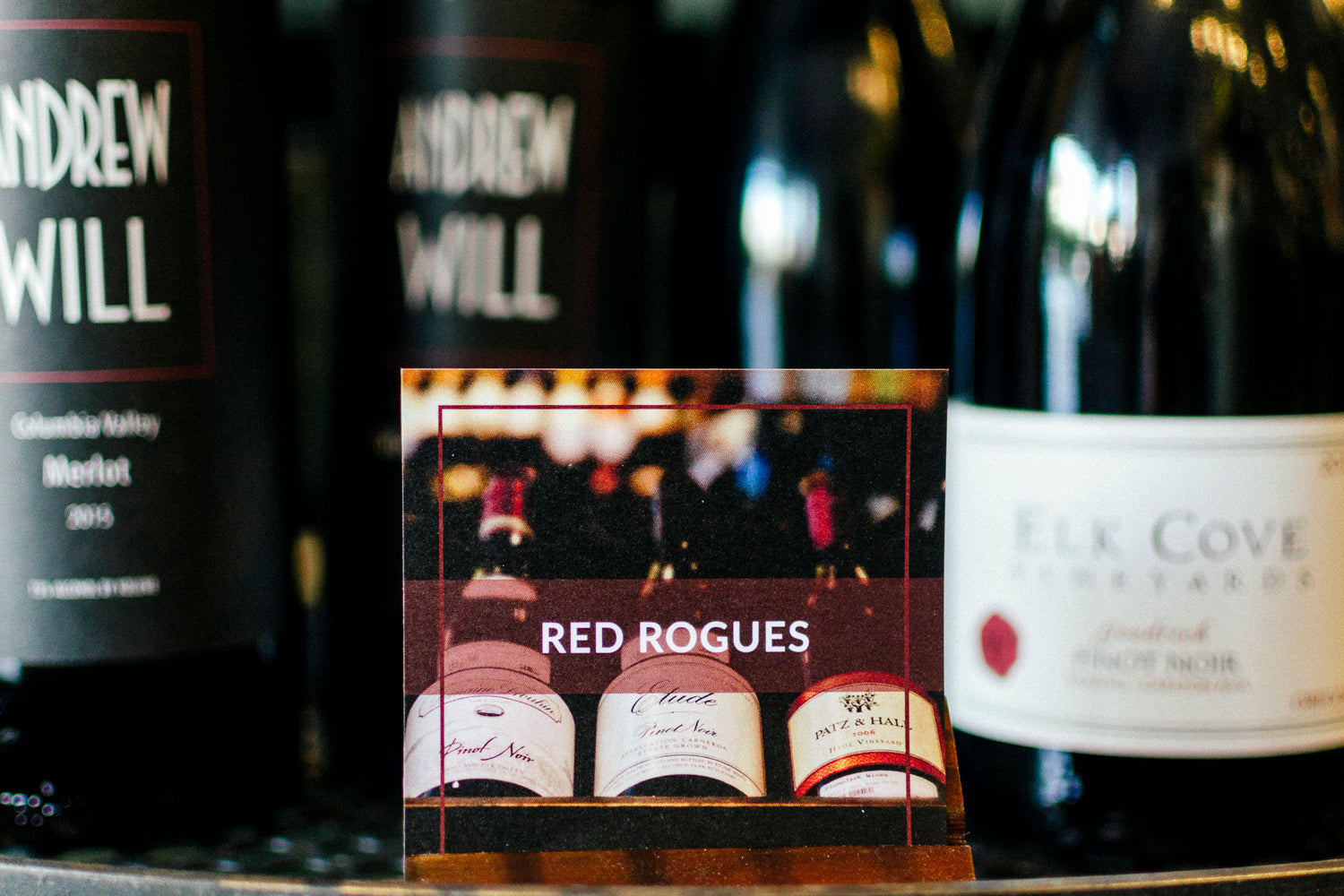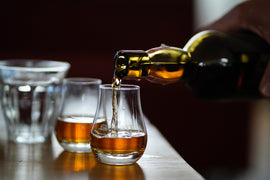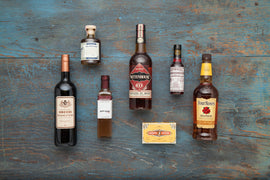Grenache, (also known as Grenache Noir, to distinguish it from its white counterpart Grenache Blanc) is the most widely planted grape in the southern Rhône Valley, and the second most widely planted grape in the world. With its upright growth and strong, sturdy trunk, Grenache is ideally suited to being grown as a water-seeking bush vine in hot, windy areas. Its only disadvantage is its predilection to set relatively little fruit, but that, of course, means all the more flavor in the grapes that remain.
Grenache is known by local names (Alicante, Carignane Rousse) in the Mediterranean regions of France. The Spanish know this grape and wine as Garnacha or Garnacha Tinta, where it is the dominant red wine variety in Catalonia and prominent in Rioja. It is also known in Italy as Tocai Rosso in Veneto and as Cannonau on the island of Sardegna. Yet as widespread as Grenache is, it’s one of the least heralded international grapes. While blending with other grapes has never held back Cabernet Sauvignon from becoming an international star, Grenache has not ascended similarly. It is typically blended with Syrah and Mourvèdre in France and Australia, and with Tempranillo in Rioja, but reaches its peak in the wines of Châteauneuf-du-Pape, where it comprises 70% of the appellation’s acreage.
Grenache appears to have originated in Spain, most likely in the northern province of Aragon, and ampelographers believe that Grenache was the foundation of Aragon’s excellent vin rouge du pays. From Aragon, it spread throughout the vineyards of Spain and the Mediterranean in conjunction with the reach of the kingdom of Aragon, which at times included Roussillon and Sardinia. A precept of agro-archaeology is that areas of great variance usually indicate birthplace. Genetic evidence that Sardegna has only a single color and a single clone of Cannonau strongly suggests that Spain is this grape's origin, where three colors and other mutations of Garnacha exist. By the early 18th century, the varietal had expanded into Languedoc and Provence. The phylloxera epidemic of the late 19th century indirectly increased European plantings of Grenache. In Rioja, for example, vineyards were replanted not with the native varietals, but with the hardy, easy to graft Grenache. A similar trend occurred in southern France, as the percentage of Grenache plantings after the phylloxera infestation increased significantly, replacing the previously abundant Mourvèdre.
Grenache was brought to California in the 1860’s, where its erect carriage, vigor and resistance to drought made it a popular planting choice. Charles Lefranc, who established Almaden Winery in the Santa Clara Valley as the state's first winery, probably introduced Grenache in a planting spurt not long after his initial success. Until surpassed by Merlot in the 1990’s, Grenache was the third most planted red variety in California after Zinfandel and Cabernet Sauvignon. Much of this acreage is in the Central Valley and used to produce bulk rather than premium wine. In recent years, Grenache plantings in California have declined as the demand for bulk wine in the Central Valley has shifted toward Cabernet Sauvignon and Pinot Noir. However, while overall Grenache acreage has declined (largely low-quality plantings in the Central Valley), the varietal has at the same time undergone something of a resurgence in popularity, with more than 1,000 new acres planted in the last 15 years in high quality coastal appellations, with the greatest number concentrated in Santa Barbara and San Luis Obispo counties.
It’s hard to pin down a definitive style, but it’s fair to say Grenache is usually full-bodied, soft, and low in acidity. The French term for the local Mediterranean wild herbs, ‘garrigue,’ is often used by experienced tasters to describe the flavor nuances of Grenache. Some Grenache are pretty powerful (usually due to Syrah and Mourvèdre being blended in), others can be easy-drinking. When done well, single varietal Grenache offers a rich core of fruit with good acidity and balance and just the right amount of tannins to match well with many different dishes without overpowering them. It pairs beautifully with braises and stews such as long, slow-cooked roasts of pork or lamb. Try it with: casseroles of potato gratin layered with wild mushrooms; roasted root vegetables in olive oil with basil, herbs de Provence, and wine; chicken and black olives; squabs rubbed with anise or garlic, wrapped in bacon; rabbit and pork sausages; roasted salmon, ahi tuna, and other fish dishes that are served with caramelized onions and other vegetables. It is surprisingly good with dishes that contain cooked tomato and eggplant.
2016 “Liberty” Domaine La Barroche $34.00
Domaine la Barroche is one of the older properties in the Châteauneuf-du-Pape appellation, dating back to the 17th century. The estate was founded when Alexandre Barrot began obtaining land in Châteauneuf-du-Pape. Those original purchases, which became what we know of as Domaine la Barroche, along with more land bought at later dates, have remained in the hands of the same family for hundreds of years. Julien Barrot is one of the young, emerging talents of the southern Rhône. After Julien completed his winemaking course in Montpellier he backpacked around the vineyards of France and Australia, and then came back and joined his father in 2002, more convinced than ever of the importance of terroir. Julien's enthusiasm and passion rubbed off on his father and together they agreed to release the first Domaine-bottled wines in the 2003 vintage. For thirty years previously Julien's father Christian had been working the vineyards and making wine but selling it off in bulk to local merchants. Though Christian is still around to lend advice, he entrusted the entire Domaine to Julien as of the 2006 vintage. The estate is small, encompassing 12 ha, and is planted to the traditional varieties including Grenache, Mourvedre, Syrah, Cinsault, Terret Noir, and Clairette. The average age of the vines is 60 years old, and one third of the vineyard is more than 100 years-old (Grenache.) Rigorous bud pruning, green harvesting and leaf thinning are done during the growing season. The picking is entirely by hand, with sorting in the vineyard and again in the cellar. The gravity-system cellar was built in 1930, and wine-making takes place in underground concrete vats. After the destemming of underripe stalks, the wine stays on the skins for over 4 weeks followed by gentle extraction. Aging takes place in old oak casks and 600 liter barrels for approximately 18 months. The wine is not filtered before bottling.
In 2015, Domaine la Baroche added a new wine to their portfolio, “Liberty”, which is sold as a Vin de France, that Julien made with friend Yannick Alliaud. Drawing on the famous motto of the French Revolution, liberté, égalité, fraternité, but also referring to the Franco-American sentiment of the Statue of Liberty, the wine is made from grapes that come from 65-year-old vines just outside Châteauneuf-du-Pape, in the southernmost part of the Rhône valley next to Châteauneuf de Gadagne. The land is very similar to the Crau plateau in Châteauneuf du Pape. The vines grow on Plio-Quaternary terraces covered with river stones, at an altitude of 125 meters, on sun-drenched hillsides, watered by tributaries of the Rhone River and windswept by the Mistral. These old vines are warmed by the thick carpet of large river stones and draw all their nourishment from a mixture of sand and red and blue clay, which keeps them cool, even during the hottest seasons. The 2016 “Liberty” is a blend of 62% Grenache, 18% Mourvedre, 13% Syrah, 5% Cinsault, 1% Vaccarese, and 1% other local varieties. The Grenache comes from a plot at the junction of "Palestor" and "Bois Dauphin" districts, and one at the junction of the "Grand Pierre", "Rayas", "Pointu" districts, as well as "Cabrières", "Boursan" and "Pied Long" blocks. The Mourvèdre comes from "Les Mascaronnes" and "Boursan" plots, and the Syrah comes from "Le Parc" and "Cabrières" plots. The Cinsault is from "Pierre à feu" plots, and finally the remainder Vaccarese and other local grapes from representative soils of Châteauneuf-du-Pape (yellow and red sand, red clay, large pebbles) with a high proportion of sand. The average age of the vines is more than 70 years old. The 2016 “Liberty” by La Barroche is a full-bodied wine with good structure, character and tight tannins. Its aromas are reminiscent of juicy, black raspberries, violets, and peppery herbs. It is mellow, yet has good acidity and elegant minerality. It is as good as any Chateauneuf du Pape, but at half the price!
2015 “Veratón” Alto Moncayo $32.00
Campo de Borja, in north-central Spain, is a DO (Denominación de Origen) in the autonomía of Aragón, and received DO classification in 1980. Aragón is nestled against the Pyrenées Mountains, surrounded by the prime wine regions of Catalonia and La Rioja. The region has a long history of viticulture which dates back centuries and was closely linked to monastery life. Despite losing much of its population and economic activity since the Spanish Civil War of the 1930’s, the region still nurtures old, head-trained vines in the rocky soils on and around the mountains of the Sistema Iberico range, of which El Moncayo, at 7,592 feet, is the highest peak. In the 1950’s, Campo de Borja growers formed a cooperative winery, which, like so many of its peers, mainly sold bulk wine at low prices for local consumption. The co-op partnered in the 1990’s with American importer Jorge Ordonez to bring its Borsao brand to the United States. In 2001, they joined with Australian winemaker Chris Ringland to create a new, much more ambitious wine venture called Alto Moncayo, which debuted with the 2002 vintage. The winery is located in the highest part of the town of Borja (500m above sea level), and from there one can see the Santuario de la Misericordia (Shrine of Mercy) and La Muela de Borja to the northwest, the Ebro Valley and the Pyrenees to the north, the Sierra de Tabuenca and Huecha valley to the south-east, and to the south-west, El Moncayo, which gives the winery its name.
Chris Ringland is one of the world’s greatest, most talented winemakers. Multiple 100 point accolades for his iconic, Aussie Three Rivers/Chris Ringland Shiraz put him on the wine world’s radar, but he was already making great wine at the historic, mailing list-only Rockford Winery in the Barossa before that. Now, with a few vintages under his belt at Alto Moncayo, Chris is doing the same thing, just this time it’s with old-vine Garnacha. The Garnacha of Alto Moncayo is different from the rest of the Campo de Borja Denominación de Origen (DO) area. This is due to the very strict selection made from the vineyards, the type of soil in which they are grown, the microclimate, and the age of the vines. As these vines are very old, the strains are very well-balanced, with a very deep root system. Grapes are sourced from 62 hectares (153.2 acres) of old clone Garnacha vines planted on hillside vineyards oriented to the southwest in 3 villages. The vineyards are composed of very unique soils of red clay (indicative of being rich in iron) mixed with red slate, and there are a few sites that have calcareous soils. Because of its hillside location, the soils are very poor in organic matter and shallow, resulting in stressed vines that produce very flavorful fruit. The climate here is Continental with hot summers and cold winters. Cool temperatures at nighttime moderate the effect of the hot days throughout the summer growing season.
The 2015 Veratón is 100% Garnacha and comes from vines that are 30 to 50 years old. The vineyards are located in Tabuenca and Borja, are planted with indigenous clones of Garnacha, and have soils that are calcareous, iron-rich, clay, gravel, and stony. The carefully-selected and perfectly-matured bunches are placed into small stainless-steel tanks for a temperature-controlled fermentation. The wine is then transferred to French and American oak (80% new, 20% second use) and aged for 16 months before bottling. The 2015 Veratón is plush and dense, with exuberant, ripe fruit flavors and toasty, coffee-scented oak. Though opulent, it is balanced by well-integrated tannins and very fresh acidity, thanks to the high altitude. A heady bouquet evokes ripe red berries, anise, mocha and pungent fresh flowers. Supple and sweet on entry, then more structured in the middle, the wine offers deep, mineral-accented dried strawberry and cherry liqueur flavors. It takes a spicy turn on the long finish, which echoes the pure red berry fruit flavors.
2014 “Verve” Sanguis $45.00
Latin for blood, Sanguis is Matthias Pippig’s creation. Pippig, a native of Bavaria, left Germany for the United States at age 18 to study studio recording, but in his words, discovered it to be “not so fun,” so he quit. His subsequent career was in San Francisco Bay area restaurants with an emphasis on wine. He went to work for an importer specializing in Mark de Grazie Italian selections, which he says was “a great education” into wine. From there Pippig spent 12 years working for La Brea Bakery in sales, marketing and business development, while at the same time using that experience to fund the wine company that would become Sanguis. Sanguis makes unique small production blends from the best low-yielding, cool climate vineyards of Santa Barbara county. Matthias sources from a handful of sites with blocks that are planted “100 percent” to his specifications. These special vineyards, combined with sustainable farming, low yields, optimal ripeness, and the gentlest handling and patience in the cellar are what make Sanguis wines what they are. Each wine produced is a unique blend, bearing a different name and label. Pippig changes blends yearly in his Rhône and Bordeaux style wines, hand sorts each wine, and never makes the same wine twice. Pippig’s process is quite similar to that of his former La Brea Bakery boss Manfred Krankl, the celebrated cult winemaker whose Ventura County-based Sine Qua Non label put him on the cover of Wine Spectator. Both are from Europe (Krankl is Austrian; Pippig is German), both name their barrels rather than numbering them, both taste and blend wines blindly (so preconceived notions don’t get in the way), both make their own art for their labels, and both sell their wines at pretty high prices (although Pippig’s $50-$100 range doesn’t touch the $500 or so that Krankl’s bottles get at auction). Pippig characterizes Sanguis wines as “big, expressive, powerful and with depth,” but notes that these characteristics do not come at the expense of balance.
The 2014 Verve is a blend of 75% Grenache, 20% Syrah and 5% Roussanne. The wine was fermented with 30% whole cluster inclusion on native yeasts, and aged a little over two years in 400 and 500-liter seasoned French Oak puncheons and stainless-steel tanks. The Grenache and Roussanne come from the Watch Hill Vineyard in the Santa Ynez Valley, and the Syrah is from the Bien Nacido Vineyard. Watch Hill Vineyard & Ranch is located in Los Alamos Valley, a relatively cool site about half-way between Santa Maria and Santa Ynez. This unique area is cooler than the Santa Ynez Valley but a bit warmer than the Santa Maria Valley. The ranch is located on approximately 122 acres of verdant and rich ground, surrounded by cattle ranching and other vineyards. These grapes are typically lower in potential alcohol content, higher in acidity, and as a result can take longer to reach their potential and of course last longer in the bottle. Grapes produce flavors of black olive, red cherries, crushed raspberries, violet floral notes, white pepper, and that earthy essence that smacks of the forest floor. Located in the Santa Maria Valley, Bien Nacido Vineyards is planted primarily to Chardonnay, Pinot Noir, Pinot Blanc, and Syrah. The original plantings came from stock grown by the University of California at Davis and grown on their own rootstock. Bien Nacido has the distinction of being the first vineyard in California to grow cool climate Syrah. Matthias says, “The ethereally perfumed Grenache grown in the sandy soils of Alisos Canyon loves to play with other varietals (such as Syrah, Petite Sirah, Petite Verdot, and occasionally Cabernet Franc, Viognier, or Roussanne) to complement and anchor its frolicsome character.” As with most of his wines, the precise varietal composition and ratios that go into Verve varies with each vintage. The 2014 Verve offers a stunning, layered, seductive style, that is seamless, beautifully balanced, complex, and elegant. This Grenache blend is reminiscent of a highly rated Gigondas (in the best vintages) as it’s simply irresistible now and will reward your palate for years to come. A lavish mouthfeel with Cashmere-like texture reveals opulent plum and ultra-ripe cherry flavors that are balanced with Asian spice, dark chocolate, blueberry jam and Bing cherries.





